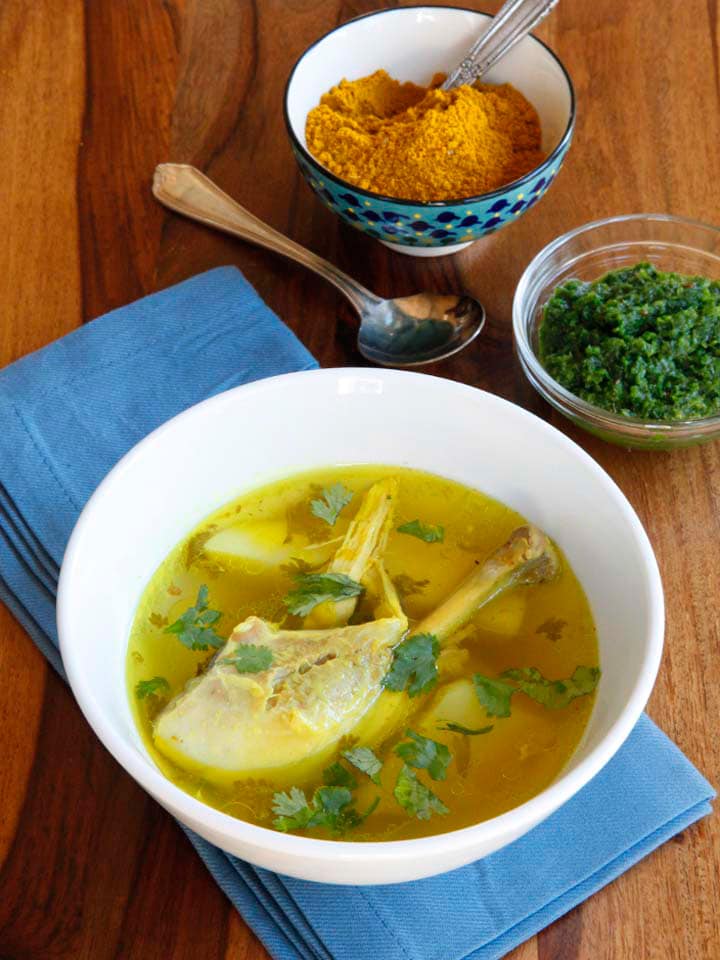
Learn to make Yemenite Soup with Chicken or Beef – traditional spicy soup recipe made with hawayej spicy blend. Warming, filling and full of flavor.
Nobody knows exactly how a group of several thousand Jews settled in Yemen. Oral Yemenite tradition suggests that a group of Jews left Jerusalem after hearing Jeremiah predict the destruction of the first Temple. Archaeological evidence shows that Jews have lived in Yemen since at least the 3rd century CE. Though it’s not exactly clear how or when they arrived in Yemen, the history of Yemenite Jews distinguishes them from all other Jewish populations. Because of their remote location and relative isolation, Yemenite Jewish tradition has remained largely unchanged throughout the centuries. They preserved many ancient Jewish religious customs that might otherwise have been lost to the passage of time. In fact, some researchers believe that the Yemenite Hebrew dialect is more closely related to Biblical Hebrew than any other dialect.
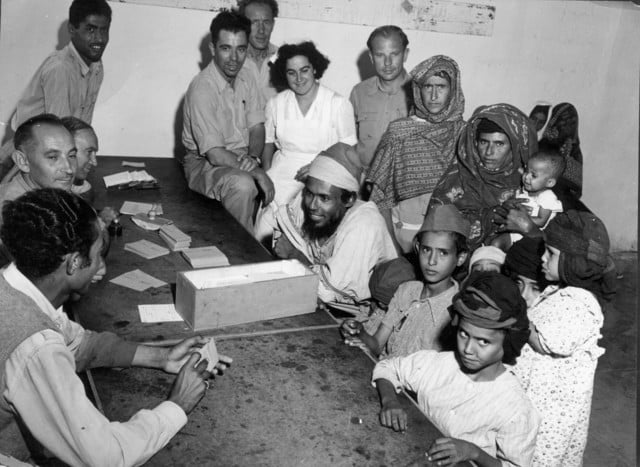 A family of Yemenite immigrants, 1948 or 49. Source: Wikimedia Commons
A family of Yemenite immigrants, 1948 or 49. Source: Wikimedia Commons
In the late 1800’s, the first in a series of mass migrations to Israel began. Facing increased persecution from Muslim communities in Yemen, most Yemenite Jews immigrated to Israel before 1962. As of 2013, less than 90 Jews still lived in Yemen.
 Yemenites emigrate to Israel during “Operation Magic Carpet,” a secret operation conducted by the Israeli government to bring Yemenite Jews to safety. Source: Wikimedia Commons
Yemenites emigrate to Israel during “Operation Magic Carpet,” a secret operation conducted by the Israeli government to bring Yemenite Jews to safety. Source: Wikimedia Commons
The Yemenite Jews are known for their complex spices and rich, flavorful dishes. I was introduced to Yemenite cuisine for the first time at a Los Angeles restaurant called Shula and Esther, owned by two Yemenite women. Their soup was my favorite; it was spicy, rich and delicious. Some days they featured lamb or beef Yemenite soup and some days chicken. Since then I’ve tasted many versions of Yemenite soup, including several in Israel where the majority of Yemenite Jews now live. When Shula and Esther closed (a tragic day for us), I had to figure out how to make the soup on my own. I learned the basic method and ingredients from my friend whose mother has Yemenite ancestry. Over time I’ve looked at various recipes and adjusted the seasonings until I honed in on the distinct flavor that we remember from Shula and Esther.
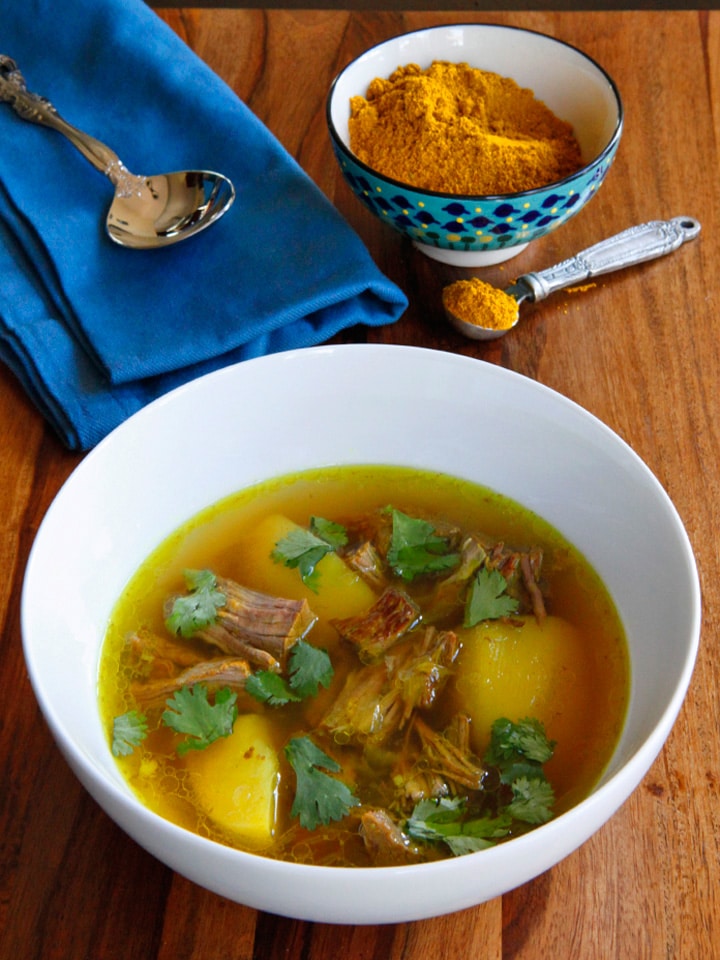
Yemenite soup is traditionally served as the entree of the Shabbat meal on Friday evening. The Jews of Yemen typically used chicken in their soup because meat was expensive and difficult to come by. The meat version has gained popularity throughout Israel. I’ve provided a recipe for each version in this blog. The broth of this soup is spiced with hawayej, a Yemenite spice blend that can be purchased at most Jewish markets. If you don’t have a market like that nearby, you can check out my recipe for hawayej by clicking here. It’s even better when made fresh and ground from whole spice seeds.
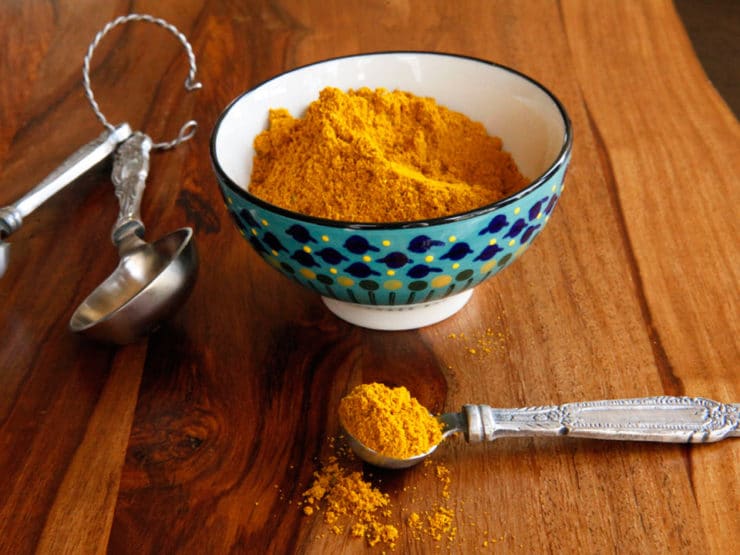 Hawayej spice blend – click here for recipe
Hawayej spice blend – click here for recipe
Every Yemenite family has a different recipe for this soup, but the basics remain the same– a meat or chicken broth, marrow bones, onions, potatoes, and hawayej. This soup is generally served with two Yemenite condiments, hilbeh and schug. Hilbeh is a gelatinous sauce made with fenugreek seeds; it takes 2-3 days to make and the process is quite involved. Schug is a sort of Yemenite salsa made from peppers, garlic, and spices. I have a green recipe for schug here and I plan to cover hilbeh in a future blog.
Note: these recipes have been retested, updated and rephotographed since they were originally posted.
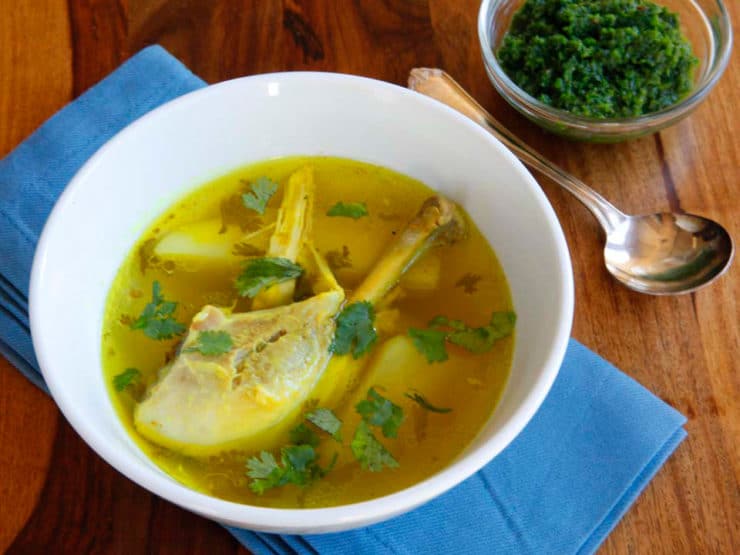
Recommended Products:
We are a participant in the Amazon Services LLC Associates Program, an affiliate advertising program designed to provide a means for us to earn fees by linking to Amazon.com and affiliated sites. As an Amazon Associate I earn from qualifying purchases.
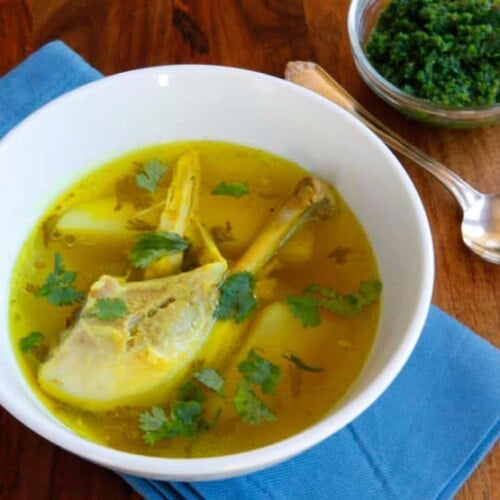
Yemenite Soup
Ingredients
Yemenite Chicken Soup Ingredients
- 1 whole chicken 3-4 pounds, cut in pieces
- 4 chicken drumsticks
- 2 beef marrow bones
- 2 teaspoons turmeric
- 3 cloves garlic
- 1 bunch cilantro cleaned, rinsed, and tied in a bundle, plus more cilantro to garnish soup
- 1 large onion rinsed and halved, skin on
- 2 teaspoons hawayej spice blend see link in notes
- 1 1/4 pounds russet or Yukon gold potatoes (about 4 medium russets) peeled and cut into large 2-inch chunks
- Salt and pepper
Yemenite Beef Soup Ingredients
- 3 tablespoons extra virgin olive oil divided
- 2 medium onions peeled and diced
- 2 pounds beef stew meat, cubed lamb can also be used
- 2 beef marrow bones
- 1/2 tablespoon turmeric
- 1 1/2 teaspoons hawayej spice blend
- 2 cloves garlic
- 1 bunch cilantro cleaned, rinsed, and tied in a bundle, plus more cilantro to garnish soup
- 1 1/4 pounds russet or Yukon gold potatoes (about 4 medium russets) peeled and cut into large 2-inch chunks
- Salt and pepper
NOTES
Instructions
To Make Yemenite Chicken Soup
- Place chicken pieces and marrow bones on the bottom of a 6-8 quart stock pot. Add 12 cups water to the pot. Bring to a boil and simmer for a few minutes, skimming the foam that rises to the top.

- Stir 2 tsp turmeric, 1/2 tbsp salt, 1/4 tsp black pepper and garlic cloves into the pot. Add the cilantro bundle and onion, bring to a boil. Reduce heat to a low simmer. Let the soup cook for 90 minutes, keeping an eye periodically to make sure the simmer is low and bubbling but not boiling too rapidly. Stir gently a few times during cooking.

- After 90 minutes, use a pair of tongs to pull out the onion, the cilantro bundle and the two chicken breasts on the bone. Place the chicken breasts on a cutting board. Pull the meat from the bones and shred it. Discard the bones and skin.

- Add the chicken breast meat back to the soup pot. Stir 2 tsp hawayej spice blend into the broth along with additional salt and black pepper to taste. I usually add about 1 tsp more of salt, it really makes the spices pop. Add the potato chunks to the broth. At this point, you can also add other vegetables if you wish, including small slices of carrot, celery, zucchini, etc. Bring back to a low simmer and continue to cook for 15-20 minutes more, or until the largest potato chunks are tender (and the other veggies, if you decide to add them).

- Scrape the marrow out of the bones and add it to the broth, if desired, or serve the marrow bones with soup to anybody who enjoys them. Serve each bowl with a few potato chunks, a chicken leg, and some of the other chicken meat. I usually remove the skin and cartilage from the chicken pieces prior to serving for a nicer presentation. Garnish each bowl with fresh chopped cilantro. This soup is usually served with schug alongside; it can be stirred into the broth to add more spicy flavor.

To Make Yemenite Beef Soup
- In a heavy 6 quart pot, heat 2 tbsp olive oil over medium high. Sprinkle the meat chunks with salt and pepper. Add the meat to the pan and sear it, stirring occasionally, until browned on all sides.

- Pour meat into a bowl and reserve. Drain the excess fat from the pot. Add another 1 tbsp olive oil to the pot and add the chopped onions. Let the onions cook for several minutes until they are softened and brown, stirring occasionally and scraping up the brown bits from the bottom of the pot as they cook.

- Add meat chunks back to the pot along with the marrow bones. Cover with 14 cups of water. Bring to a simmer, skimming any foam that rises to the top.

- Stir in 1/2 tbsp turmeric and 1/2 tbsp salt. Add the cilantro bundle and the garlic cloves. Reduce heat to a low simmer. Let the soup cook for 2 1/2 hours, keeping an eye periodically to make sure the simmer is low and bubbling but not boiling rapidly.

- After 2 1/2 hours your meat chunks should be quite tender. Remove the cilantro bundle. Stir 1 1/2 tsp hawayej spice blend into the broth along with additional salt and black pepper to taste (I usually add 1 to 1 1/2 tsp more of salt, but we like things on the salty side). Add the potato chunks to the broth. Bring back to a simmer and continue to cook for 15-20 minutes more, or until the largest potato chunks are tender.

- Scrape the marrow out of the bones and add it to the broth, if desired, or serve the marrow bones with soup to anybody who enjoys them. Serve each bowl of soup garnished with fresh chopped cilantro (optional). This soup is usually served with schug alongside; it can be stirred into the broth to add more spicy flavor.

Nutrition

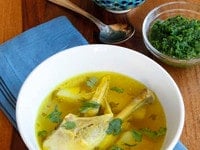
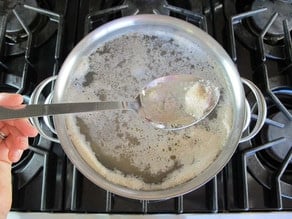
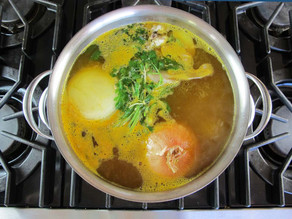
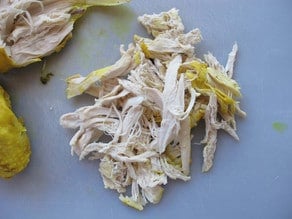
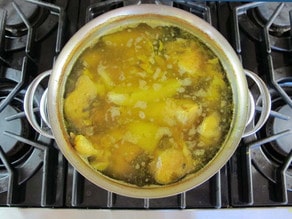
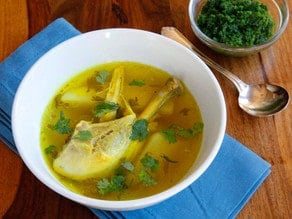
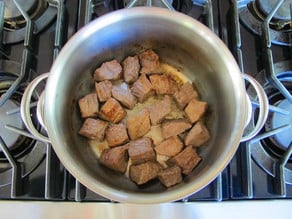
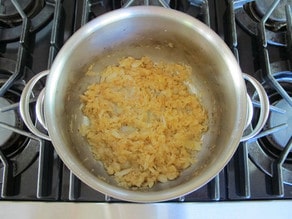
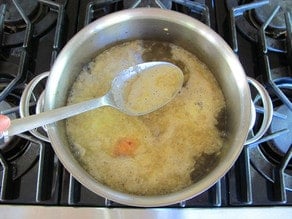
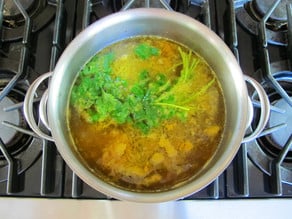
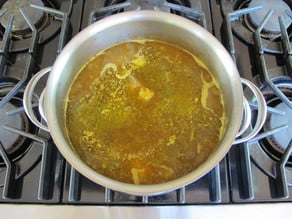
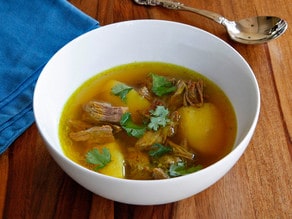


This is the best soup EVER. I keep making it, discarding my ashkenazi roots for a very flavorful, delicious, satisfying soup.
used beef bones short ribs no marrow bones 1 onion tasty!
You can also find Hawayej at Arabic Markets
This was delicious
I made the beef one and also added carrots and was yummy!
Can I freeze this soup?
Thank you so much for posting the recipe for the hawayej spice. This is one spice I’ve been wanting to learn in a long time as we don’t get it in my country. Can you give me a recipe of some guidelines on doing a vegetarian version of this soup. Would really appreciate. Thanks
Tori, thank you for all you do.
I really appreciate you providing us with the delicious Yemenite recipes, and recipes for the spice combinations. These are delicious meals and brings back great memories. Much love.
????♀️
Aww thanks for writing Soonee! So happy you’re enjoying the recipes.
The first time a made this I did not cover the pot at any time.It was very tasty, but the broth had simmered down .
The second time I made this I did cover the pot during the whole cooking time and added some extra water. It was not as tasty
So am I correct in thinking that leaving the lid off is the way to cook it. Any suggestion to get more liquid with flavor
Thanks
I like your recipe for the chicken Yemenite soup very much ,it’s so easy
Hi Eileen, you are correct it is supposed to cook uncovered. I always mention in a recipe if it needs to be covered with a lid. If you need more liquid than you would get after cooking it down, you can add a few more dark chicken pieces and up the amount of spices, then add some extra water before cooking. I would still recommend cooking it uncovered though. Good luck!
Hi Adina,
Thanks for the recipe. I am going to make it for the first time for a Yemenite friend who is coming to visit. I have my hawaijj in the fridge for about half a year. Do you think it is still good or need I buy a fresh one? Thanks in advance
Love that you read through the comments and found my Hebrew name. 🙂 Your hawayej spice blend should be just fine. I don’t keep mine in the refrigerator and the flavor is still good for 1-2 years. After that it will lose some flavor slowly over time, but still usable. I do try to replace old spices and blends every 2 years (I date the bottles) and herbs every 1-2 years.
Tori, thanks so much for the recipe! My husband is Yaman from Israel and he loved it! Made the beef version several times. Now his friends came over from Israel so I’m making it again. Super delish! Thanks again!
Just made the yemenite chicken soup and it came out very nice. I took it mild on the spices but still the flavor is strong. My little community appreciates you sharing these consise instructions plus a little bit of the very spirit of the yemenite community;) le haim.
Iggy
Hi love your recipes. Is there a way to modify for a crackpot version.
Would love to set up to cook before shabbat to then have on a cold winter shabbat day.
Thanks
Hi Dan, Tori’s assistant Ashley here. Currently we have not developed a version of this recipe for the crock pot.
Hi Tori,
I am really itching to try this! I know the Jewish deli in our podunk Midwest town has it every now and then!
One thing I caught: the chicken ingredients call for 4-5 drumsticks and the method says 2 breasts.
Thank you for your work!
Hi Andrew, Tori’s assistant here. The recipe calls for a whole chicken and the additional drumsticks, so the breasts you’re seeing in the method are taken from the whole chicken. Hope this helps!
This soup looks very delicious 🙂 Also, I would like to mention that these flavors are common to all Yemenis, not just Yemeni Jews. (And I think it’s important to remember that cuisine is typically a cultural aspect of a people, not a religious one.) You can also find hawa’ij spices at a Middle Eastern market. Depending on the pronunciation in Arabic (which varies from one Yemeni family to another), hilbeh can also be spelled as hulbah/hulba and the spicy salsa is more commonly known as sahaawiq or sahaawig.
Hi Tori Avey
Can you please tell me the brands name of the ground Turmeric powder ( yellow color) used as the Yemenite soup recipe.
The ground Turmeric at my market store is orange in color; that why?…
Also I want to make yellow Falafel.
Thanks,
J. Rodriguez
Hi Juan, there are many brands. I currently use my own line of spices, which I will be launching soon. Turmeric does appear to be an orange-yellow color in the bottle, but when added to dishes (like this soup) it colors them yellow. Hope that helps!
love it and the aroma ,im teymani tahts how my mom used to make , try hilbe with this soup.
I am so excited to have found this blog! I just returned from a quick visit in Israel and am already running low on my uncle’s shlug and missing his cooking, especially this soup! Thank you for sharing
about to try your recipe! thanks for step-by-step 🙂
was wondering what makes it spicy? those spices do not usually have a kick.
any suggestions?
In this context, spicy does not relate to heat level/kick but rather the sheer potency of the spice flavors. Hope that makes sense. It has layers and layers of spice in it, but it doesn’t have a “bite” like chili peppers do.
Yummy!
I love your recipes, Tori. Share in your passion for food and flavors. Thanks so much for putting together quality presentations.